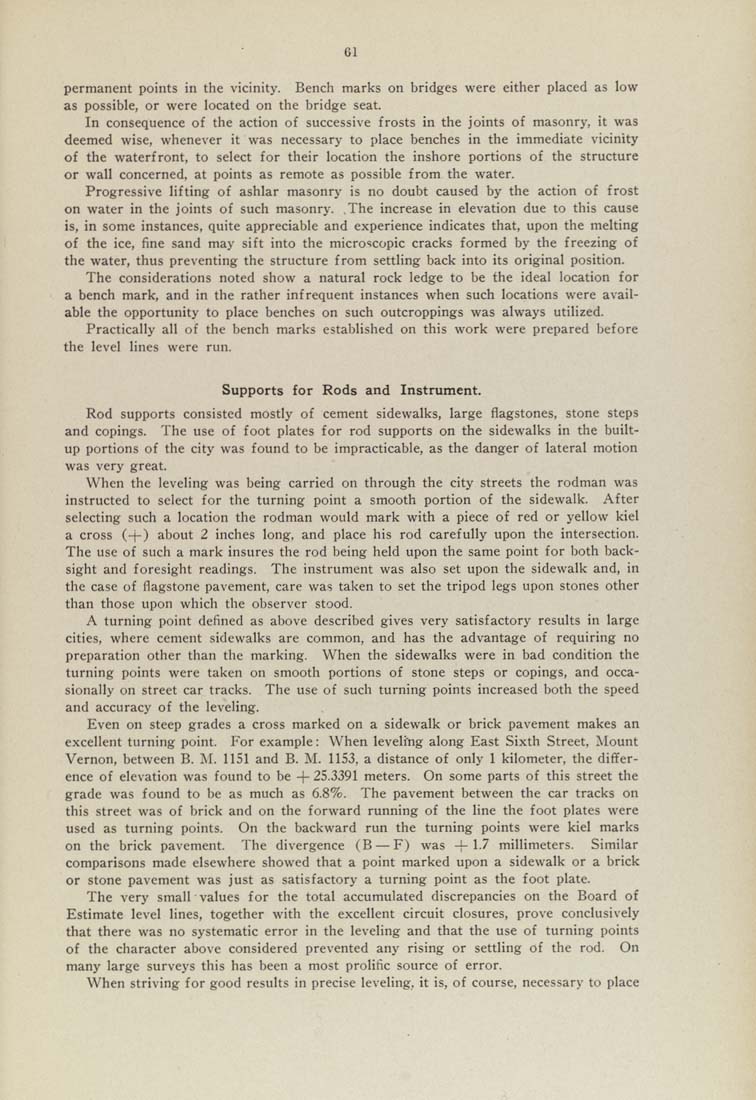61
permanent points in the vicinity. Bench marks on bridges were either placed as low
as possible, or were located on the bridge seat.
In consequence of the action of successive frosts in the joints of masonry, it was
deemed wise, whenever it was necessary to place benches in the immediate vicinity
of the waterfront, to select for their location the inshore portions of the structure
or wall concerned, at points as remote as possible from the water.
Progressive lifting of ashlar masonry is no doubt caused by the action of frost
on water in the joints of such masonry. The increase in elevation due to this cause
is, in some instances, quite appreciable and experience indicates that, upon the melting
of the ice, fine sand may sift into the microscopic cracks formed by the freezing of
the water, thus preventing the structure from settling back into its original position.
The considerations noted show a natural rock ledge to be the ideal location for
a bench mark, and in the rather infrequent instances when such locations were avail¬
able the opportunity to place benches on such outcroppings was always utilized.
Practically all of the bench marks established on this work were prepared before
the level lines were run.
Supports for Rods and Instrument.
Rod supports consisted mostly of cement sidewalks, large flagstones, stone steps
and copings. The use of foot plates for rod supports on the sidewalks in the built-
up portions of the city was found to be impracticable, as the danger of lateral motion
was very great.
When the leveling was being carried on through the city streets the rodman was
instructed to select for the turning point a smooth portion of the sidewalk. After
selecting such a location the rodman would mark with a piece of red or yellow kiel
a cross (+) about 2 inches long, and place his rod carefully upon the intersection.
The use of such a mark insures the rod being held upon the same point for both back¬
sight and foresight readings. The instrument was also set upon the sidewalk and, in
the case of flagstone pavement, care was taken to set the tripod legs upon stones other
than those upon which tlie observer stood,
A turning point defined as above described gives very satisfactory results in large
cities, where cement sidewalks are common, and has the advantage of requiring no
preparation other than the marking. When the sidewalks were in bad condition the
turning points were taken on smooth portions of stone steps or copings, and occa¬
sionally on street car tracks. The use of such turning points increased both the speed
and accuracy of the leveling.
Even on steep grades a cross marked on a sidewalk or brick pavement makes an
excellent turning point. For example: When leveli'ng along East Sixth Street, Mount
Vernon, between B. M. 1151 and B. M. 1153, a distance of only 1 kilometer, the differ¬
ence of elevation was found to be + 25,3391 meters. On some parts of this street the
grade was found to be as much as 6,8%. The pavement between the car tracks on
this street was of brick and on the forward running of the line the foot plates were
used as turning points. On the backward run the turning points were kiel marks
on the brick pavement. The divergence (B — F) was -f 1.7 millimeters. Similar
comparisons made elsewhere showed that a point marked upon a sidewalk or a brick
or stone pavement was just as satisfactory a turning point as the foot plate.
The very smalT values for the total accumulated discrepancies on the Board of
Estimate level lines, together with the excellent circuit closures, prove conclusively
that there was no systematic error in the leveling and that the use of turning points
of the character above considered prevented any rising or settling of the rod. On
many large surveys this has been a most prolific source of error.
When striving for good results in precise leveling, it is, of course, necessary to place
|








